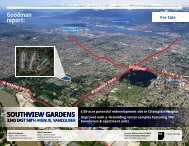Canada
MER-Canada-2016
MER-Canada-2016
Create successful ePaper yourself
Turn your PDF publications into a flip-book with our unique Google optimized e-Paper software.
TECHNICAL COMPLIANCE ANNEX<br />
birth certificate, driver’s license, passport, or other similar document. For corporations, the<br />
corporation’s existence is confirmed, and the names and addresses of its directors ascertained, by<br />
reference to its certificate of corporate status. However, other methods are acceptable, e.g. a record<br />
that it is required to file annually under applicable provincial securities legislation, or any other<br />
record that validates its existence as a corporation. The existence of an entity other than a<br />
corporation must be confirmed by reference to a partnership agreement, articles of association, or<br />
other similar record that ascertains its existence. These legal provisions meet the FATF standard.<br />
Criterion 10.4— The “Third Party Determination” provisions of the PCMLTFR require FIs to<br />
determine whether their customers are acting on behalf of another person or entity. Where an<br />
account is to be used by or on behalf of a third party, the FI must collect CDD information on that<br />
third party and establish the nature of the relationship between third party and account holder.<br />
Criterion 10.5— PCMLTFR s.11.1(1) requires FIs, at the time the entity’s existence is confirmed, to<br />
obtain the following information:<br />
Technical compliance Annex<br />
For corporations, the name of all directors of the corporation and the name and address of all<br />
persons who own or control, directly or indirectly, 25% or more of the shares of the corporation;<br />
For trusts, the names and addresses of all trustees and all known beneficiaries and settlors of the<br />
trust;<br />
For entities other than corporations or trusts (typically, a partnership fund or unincorporated<br />
association or organization), the name and address of all persons who own, directly or indirectly,<br />
25% or more of the shares of the entity; and<br />
In all cases, information establishing the ownership, control, and structure of the entity.<br />
Under the PCMLTFR, s.11.1(2), REs further need to “take reasonable measures to confirm the<br />
accuracy of the information obtained” on beneficial ownership. This requirement implies the need to<br />
use reliable sources to obtain the requisite information and the FATF standard 108 allows<br />
identification data to be obtained “from a public register, from the customer, or from other reliable<br />
sources.” Also, OSFI Guideline B-8 usefully indicates that “reasonable measures” to identify ultimate<br />
beneficial owners could include not only requesting relevant information from the entity concerned,<br />
but also consulting a credible public or other database or a combination of both. This Guideline also<br />
makes clear that the measures applied should be “commensurate with the level of assessed risk.”<br />
No specific legal provisions cover beneficial ownership of personal accounts. However, the<br />
PCMLTFR, in effect, establish beneficial ownership of personal accounts: in particular, s.9 requires<br />
REs to determine whether personal accounts are being used on behalf of a third party and, for<br />
personal accounts in joint names, all authorized signatories are subject to CDD measures.<br />
108 FATF (2013), Methodology for assessing technical compliance with the FATF Recommendations and the<br />
effectiveness of AML/CFT systems, p. 147,<br />
www.fatf-gafi.org/media/fatf/documents/methodology/FATF%20Methodology%2022%20Feb%202013.pdf<br />
140<br />
Anti-money laundering and counter-terrorist financing measures in <strong>Canada</strong> - 2016 © FATF and APG 2016




